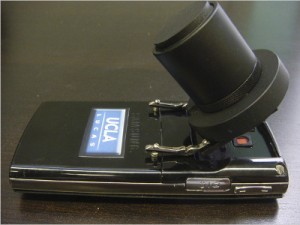Source: #innov8aid | Development Innovators Blog, June 27, 2012
You already use your cell phone to check the weather, play games, even act as a flashlight, alarm clock and stopwatch. Now a new attachment will turn your phone into a laboratory, too.
A research team in California has developed a phone attachment that can test blood or water samples – advanced microanalysis previously only possible with expensive, bulky hospital equipment. Samples could be inserted like memory sticks into the mechanical attachment, which reads the slides and provides a diagnosis in plain English – no advanced biology classes needed.
Funding came from U.S. government sources like the National Institutes of Health and the Department of Defense, which saw the potential for improving battlefield care, telemedicine and public health monitoring in big cities. But the product’s ability to function in low-resource settings makes it applicable to developing countries as well.
The technology acts like a microscope and diagnostic tool all at once, bringing the hospital to the field. It uses an algorithm that would allow a front line health worker to quickly test someone’s blood for malaria parasites, or to get a read on how well a patient’s HIV is being controlled with medication. People could also manage their health conditions by using the easy-to-use interface themselves to send test results to a clinic they otherwise couldn’t get to.
The data from these tools can be coded for location and time and copied to a central server, providing an accurate and real-time picture of a disease outbreak or a water condition for emergency responders or policymakers.
The attachment brings an army of technologies together, basically using all the cool things a cell phone can do – like connect wirelessly and do digital imaging – and putting them to work together in a new way. Dr. Aydogan Ozcan, who leads the California research team behind the attachment, said he got the idea while thinking about how he would re-do the centuries-old technology of microscopes if he started from scratch with today’s digital and electronic building blocks.
The attachment only adds 40-50 grams, the weight of around ten U.S. nickels. It can use the phone’s battery, or an added AAA.
Los Angeles-based company Holomic is aiming to commercialize the attachment within the year, and cost information on the rapid diagnostic test reader should be available by mid-summer.



